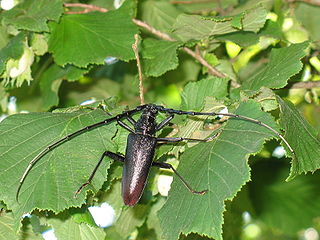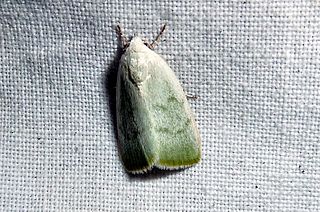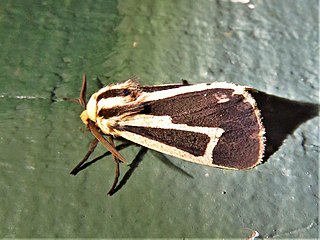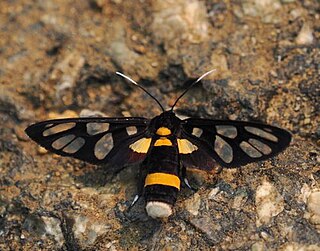
The Essex emerald is a moth of the family Geometridae. The species was first described by Johan Christian Fabricius in 1787 as Phalaena smaragdaria. It is distributed throughout the Palearctic region with records from many European countries. The British subspecies Thetidia smaragdaria maritima was last seen in 1991 in Kent and is now presumed extinct. In 2004 the moth was first recorded from Sweden.

The white-shouldered house moth is a species of gelechioid moth. It belongs to the subfamily Oecophorinae of the concealer moth family (Oecophoridae), just like the brown house moth. Though several presumed congeners of E. sarcitrella were described, its genus Endrosis is currently understood to be monotypic.

Cerambyx is a genus of beetles in the family Cerambycidae. They are commonly known as capricorn beetles, as their strong, stout and curved antennae, each segment of which flares towards the tip, are reminiscent of the horns of an Alpine Ibex or "capricorn".

Mocis frugalis, the sugarcane looper, is a moth of the family Erebidae. The species was first described by Johan Christian Fabricius in 1775. It is found in several parts of the world, including India, Sri Lanka, West African countries and other Oriental regions. The adult is a fruit piercer and a major pest of crops.

Gagitodes sagittata, the marsh carpet, is a moth of the family Geometridae. The species was first described by Johan Christian Fabricius in 1787. It is found in eastern Asia, including Japan, Korea and China and in central and northern Europe. It is sometimes included in the genus Perizoma

Olindia schumacherana, also known as the white-barred tortrix, is a moth of the family Tortricidae found in most of Europe. The moth was first described by the Danish zoologist, Johan Christian Fabricius in 1787.

Acontia nitidula, the Brixton beauty, is a moth of the family Noctuidae. The species was first described by Johan Christian Fabricius in 1787. It is found in South Africa, Europe, China, Japan and throughout India and Sri Lanka. It has also been recorded from Great Britain, but this record is doubtful.

Micropterix tunbergella is a moth of the family Micropterigidae found in most of Europe. The moths are very small and can be found feeding on the pollen of hawthorn, oak and sycamore. The larva and pupa are unknown. The moth was described Johan Christian Fabricius in 1787.

Agapanthia is a genus of flat-faced longhorn beetle belonging to the family Cerambycidae, subfamily Lamiinae.

Crambus hamella is a species of moth in the family Crambidae described by Carl Peter Thunberg in 1788. It is found in most of Europe, east to the Russian Far East and Japan. It is also found in North America, including Alberta, Arizona, Manitoba, Michigan, Oklahoma and Ontario.

Earias vernana is a species of moth in the family Nolidae first described by Johan Christian Fabricius in 1787. It is found in most of southern and central Europe.

Apantesis vittata, the banded tiger moth, is a moth of the family Erebidae. It was described by Johan Christian Fabricius in 1787. It is found in the United States from Maryland to Florida, west to Kentucky, and Louisiana.

Eupithecia extremata is a species of moth in the family Geometridae. It is found on the Iberian Peninsula, Italy, Germany, Poland, Austria, Slovakia, Hungary and most of the Balkan Peninsula. It is also found in Turkey, Israel and Georgia.

Haplotinea insectella, the drab clothes moth or fungus grain moth, is a moth of the family Tineidae. It was described by Johan Christian Fabricius in 1794. It is found in all of Europe, except Ireland, the Iberian Peninsula and the western and southern part of the Balkan Peninsula. It is also found in North America. The species is often found in warehouses, granaries, mills and farm buildings.

Hypopyra vespertilio is a moth of the family Erebidae first described by Johan Christian Fabricius in 1787. It is found in China, Korea, Honshu in Japan, India, Sri Lanka, Nepal, Thailand, Myanmar, Cambodia, Vietnam, Taiwan, Malaysia, the Philippines, Java, Sumatra and Sulawesi.

Perina nuda, the clearwing tussock moth or banyan tussock moth, is a moth of the family Erebidae. The species was first described by Johan Christian Fabricius in 1787. It is found in the Indian subregion, Sri Lanka, to southern China Hong Kong, Thailand and Sundaland.

Roeslerstammia is a genus of moths belonging to the family Roeslerstammiidae, first described by Zeller in 1839.

Roeslerstammia pronubella is a species of moth belonging to the family Roeslerstammiidae.

Amata sperbius is a moth in the subfamily Arctiinae which was first described by Johan Christian Fabricius in 1787.




















